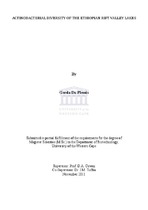| dc.contributor.advisor | Cowan, D.A. | |
| dc.contributor.advisor | Tuffin, Marla | |
| dc.contributor.author | Du Plessis, Gerda | |
| dc.date.accessioned | 2017-03-16T11:03:12Z | |
| dc.date.available | 2017-03-16T11:03:12Z | |
| dc.date.issued | 2011 | |
| dc.identifier.uri | http://hdl.handle.net/11394/5385 | |
| dc.description | >Magister Scientiae - MSc | en_US |
| dc.description.abstract | The class Actinobacteria consists of a heterogeneous group of filamentous, Gram-positive bacteria that colonise most terrestrial and aquatic environments. The industrial and biotechnological importance of the secondary metabolites produced by members of this class has propelled it into the forefront of metagenomics studies. The Ethiopian Rift Valley lakes are characterized by several physical extremes, making it a polyextremophilic environment and a possible untapped source of novel actinobacterial species. The aims of the current study were to identify and compare the eubacterial diversity between three geographically divided soda lakes within the ERV focusing on the actinobacterial subpopulation. This was done by means of a culture-dependent (classical culturing) and culture-independent (DGGE and ARDRA) approach. The results indicate that the eubacterial 16S rRNA gene libraries were similar in composition with a predominance of α-Proteobacteria and Firmicutes in all three lakes. Conversely, the actinobacterial 16S rRNA gene libraries were significantly different and could be used to distinguish between sites. The actinobacterial OTUs detected belonged to both the Rubrobacterales and Actinomycetales orders with members of the genus Arthrobacter being found in all three lakes. Geochemical properties were significantly different between the lakes, although more than one property attributed to the variance between community compositions. The diversity detected in the culture-based study differed significantly and all isolates belonged to the genus Streptomyces. Two novel strains were characterized by means of phylogenetic (16S rRNA gene sequence), physiological, morphological and biochemical analyses. Both novel isolates were capable of growing under "extreme" conditions- pH 12, 10% NaCl and 45°C. Partial enzyme characterization revealed that both strains produced xylanase enzymes that were active at pH 6.5 and 8.5 with an increase in activity up to 45°C. The results obtained revealed a previously undetected diversity of actinobacteria in the Ethiopian Rift Valley with a potentially novel subpopulation adapted to haloalkaline conditions. The low 16S rRNA sequence similarity of a substantial proportion of the libraries suggests that culture-based isolation may play a vital role in deciphering the community fingerprint. | en_US |
| dc.description.sponsorship | The National Research Foundation and the Norwegian Research Council | en_US |
| dc.language.iso | en | en_US |
| dc.publisher | University of the Western Cape | en_US |
| dc.subject | Actinobacteria | en_US |
| dc.subject | Ethiopian Rift Valley | en_US |
| dc.subject | Soda lakes | en_US |
| dc.subject | Denaturing Gradient Gel Electrophoresis | en_US |
| dc.subject | Amplified Ribosomal DNA Restriction Analysis | en_US |
| dc.title | Actinobacterial diversity of the Ethiopian Rift Valley lakes | en_US |
| dc.rights.holder | University of the Western Cape | en_US |

